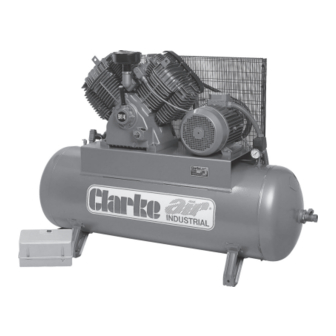Table of Contents
Advertisement
Advertisement
Table of Contents

Summarization of Contents
Safety Precautions
General Safety Rules
Key safety guidelines for operating and maintaining the air compressor, including handling compressed air, electrical safety, and operational precautions.
Noise Levels
Noise Emission Information
Information regarding the noise produced by the machine and the need for ear protection.
Installation
Site and Environment Requirements
Guidelines for selecting a suitable location, including firm/level site, dust/damp free environment, and ventilation.
Electrical Connection Requirements
Details on power cable sizing, qualified electrician involvement, fused plugs/isolators, and RCD protection.
Electrical Connections
Wire Colour Coding and Terminal Identification
Explains the standard wire colours (green/yellow, blue, brown) and their corresponding terminals (Earth, Neutral, Live).
110V Model Specifics
Instructions for connecting the 110V model, emphasizing earthing and transformer capacity.
Lubrication
Pump Oil Specification
Specifies the type of oil to use for the compressor pump, as indicated on the machine plate.
Before Starting Compressor Checks
Pre-Start Checks
Essential checks before starting the compressor, including oil level and automatic control position.
Starting and Stopping Procedures
Starting Procedure
Detailed steps for starting the compressor, including switching on the isolator, pressure switch, and checking rotation.
Stopping Procedure
Instructions for safely stopping the compressor by switching off the pressure switch and isolating the mains supply.
General Arrangement
Stationary Compressor Components
Diagram and list of parts for the stationary air compressor, including pump, motor, gauges, and valves.
Notes on Automatic Machines
Information regarding solenoid valves and Auto Star Delta starters for 10 HP and above models.
Outlet Pressure Adjustments
Portable Compressor Outlet Adjustment
How to adjust the outlet pressure on portable compressors using the adjusting knob and outlet taps.
Stationary Compressor Outlet Adjustment
States that stationary compressors are not supplied with adjustable outlet pressure facilities.
Overload Button
Motor Overload Protection and Reset
Explains how the overload detector works and the steps to reset the motor if it trips.
Trouble Shooting Chart
Compressor Will Not Start Automatically
Identifies probable causes like electrical faults, voltage drop, or pressure switch issues, and their remedies.
Fuses Keep Blowing
Addresses issues with fuses blowing, likely due to inadequate fuse size or motor faults, with corresponding remedies.
Compressor Starts, But Stops After Few Revolutions
Diagnoses causes such as non-return valve leaks/blockage or solenoid valve issues, and suggests remedies.
Trouble Shooting Chart
Compressor Unit Will Not Stop Automatically
Covers defective pressure switches as a cause for the compressor not stopping automatically.
Bleed Valve Blows While Compressor Not Running
Diagnoses non-return valve leaks as the cause for bleed valve blowing when the compressor is idle.
Bleed Valve Blows While Compressor Is Running
Identifies relief valve leaks as the reason for the bleed valve blowing during operation.
Compressor Runs Continuously & Cannot Attain Pressure
Lists causes like blocked filters, belt slack, leaks, or worn valves, and suggests solutions.
Trouble Shooting Chart
Unusual Noise From Compressor
Troubleshoots noise issues caused by loose bolts, belts, worn bearings, or broken valves, with recommended actions.
Compressor Becomes Too Hot
Addresses overheating due to insufficient ventilation, low oil, wrong rotation, or worn components, and suggests solutions.
Trouble Shooting Chart
Compressor Starts and Stops More Frequently Than Usual
Identifies causes like condensation, leaks, or small pressure differential, with suggested remedies.
Compressor Unit Starts When No Air Is Being Used
Pinpoints leaks in the pipework system as the cause for the compressor starting unnecessarily.
Compressor's Oil Consumption Rising
Explains reasons for increased oil consumption, such as overfilling, leaks, high temperature, or worn cylinders.
Oil in the Air Delivered
Attributes oil in delivered air to a sump overfill or worn cylinders, suggesting oil level correction or contact.
Condensation in Crank Case
Discusses condensation causes like over-dimensioning or short operational periods, offering solutions like oil changes or cooling reduction.
Trouble Shooting Chart
Condensation at Outlet Points
Covers incorrect piping, warm intake air, or high delivery temperature causing condensation at outlets.
Electric Motor Too Hot
Addresses overheating due to low voltage, electrical faults, or blocked cooling fins, recommending electrician consultation or cleaning.
Machine Running But Not Pumping Air
Diagnoses issues like air exhausting from the solenoid after starter change, requiring valve check.
Spare Parts and Service
Contact Information for Parts and Service
Provides telephone numbers and email addresses for ordering spare parts and obtaining technical service.
Maintenance Chart
Daily Maintenance Checks
Lists essential checks to be performed daily, such as checking the oil level and draining the air receiver.
Weekly Maintenance Checks
Details checks to be performed weekly, including cleaning the intake filter and oil breather.
Six Monthly Maintenance Checks
Outlines maintenance tasks to be done every six months, such as changing the oil and checking the non-return valve.
Torque Values for Cylinder Head Bolts
Cylinder Head Bolt Torque Specifications
Provides specific torque values (NM) for cylinder head bolts across different model numbers for proper assembly.
Declaration of Conformity
Product Compliance Standards and Details
Declares the product's compliance with specific EU standards/directives, product description, model number, and declaration date.

















Need help?
Do you have a question about the VE Series and is the answer not in the manual?
Questions and answers